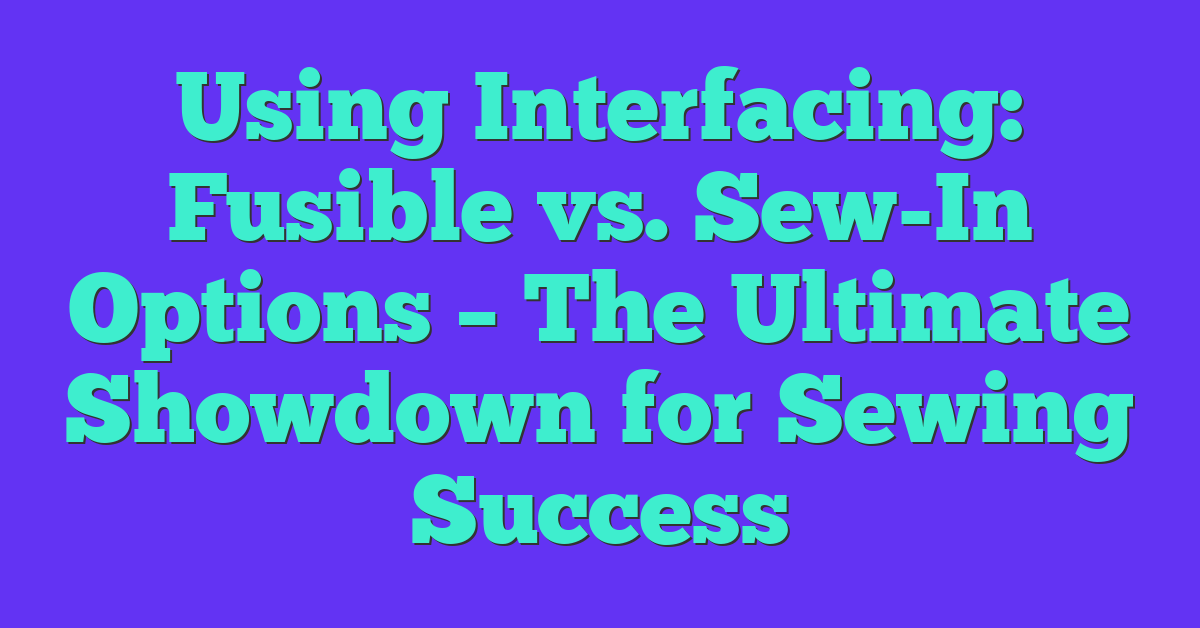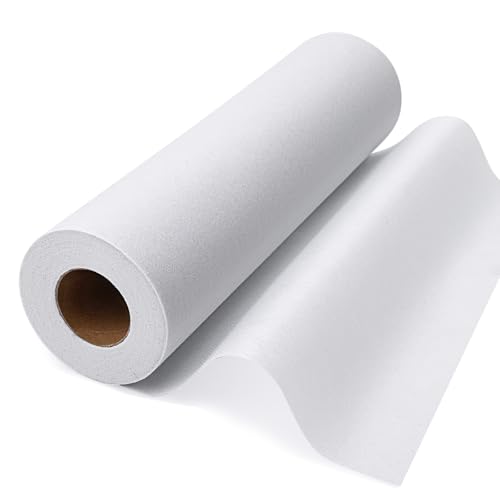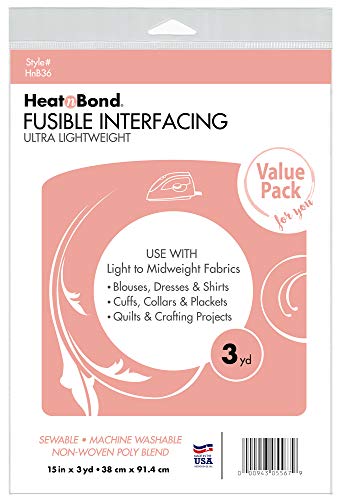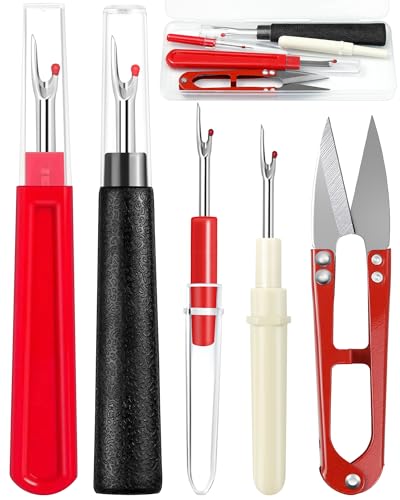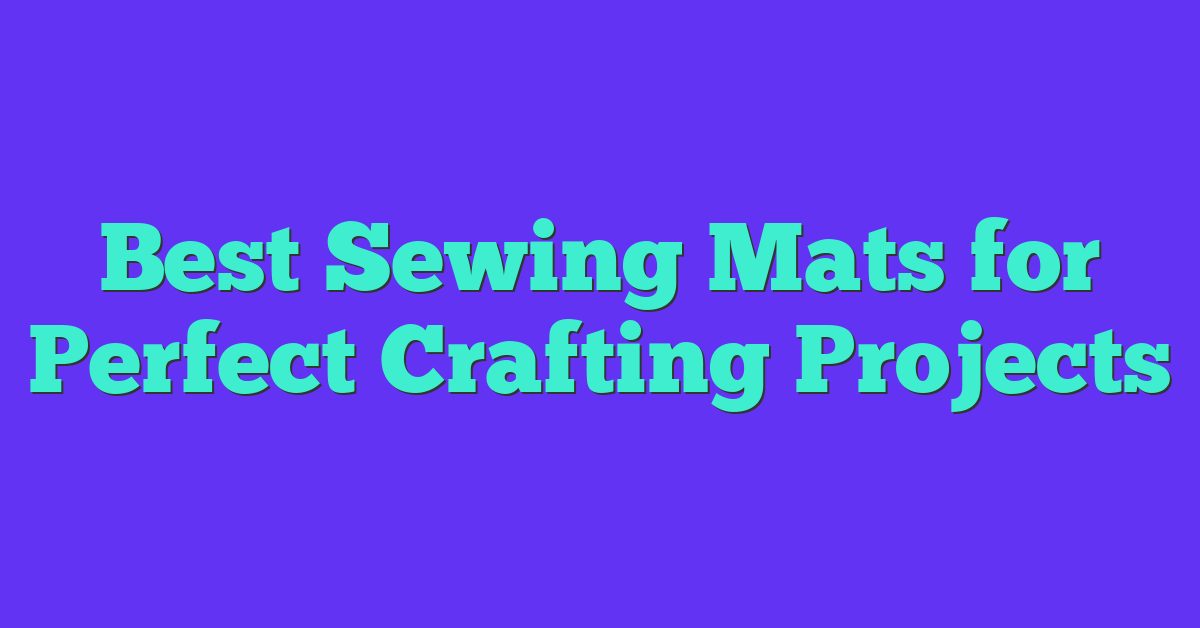I’ve always found that the right interfacing can make or break a sewing project. Choosing between fusible and sew-in options can be a bit overwhelming, especially if you’re just starting out. Let’s dive into what sets these two types apart and how each can benefit your crafting.
Fusible interfacing is perfect for those quick fixes and simple projects, offering convenience with its easy application. On the flip side, sew-in interfacing provides a more tailored finish and is ideal for garments that need extra durability and flexibility. By understanding the unique advantages of each option, you can make informed choices and enhance the quality of your sewing projects.
Understanding Interfacing
Interfacing reinforces fabrics, providing structure and stability. It enhances areas like collars, cuffs, and waistlines for a polished finish. Various weights cater to different projects:
- Lightweight: Suitable for delicate fabrics
- Medium: Ideal for shirts and blouses
- Heavy: Supports outerwear and structured garments
Interfacing types fall into two categories:
- Fusible Interfacing: Features an adhesive backing that bonds with heat, simplifying application. Examples include cotton fusible and polyester blends.
- Sew-In Interfacing: Requires stitching to the fabric, offering flexibility and durability. Examples encompass woven and non-woven sew-in interfacing.
Selecting the appropriate interfacing improves garment quality. I choose fusible interfacing for efficiency and sew-in for projects needing lasting structure.
Fusible Interfacing
Fusible interfacing streamlines the sewing process by bonding directly to fabrics. I use it frequently for its ease and efficiency.
Benefits
- Ease of Application: I iron fusible interfacing onto fabric surfaces, saving time compared to sewing.
- Consistent Adhesion: Provides uniform support, ideal for areas like collars, cuffs, and waistlines.
- Versatility: Available in lightweight, medium, and heavy weights, suitable for various projects such as shirts, jackets, and skirts.
- Time-Saving: Eliminates the need for additional stitching, making it perfect for quick fixes and simple garments.
- Wide Availability: Easily found in most fabric stores, offering numerous brands and types to choose from.
Drawbacks
- Limited Flexibility: May restrict fabric movement, which isn’t ideal for garments needing high flexibility like evening dresses.
- Potential for Bubbling: Improper application can cause bubbles or wrinkles, affecting the garment’s appearance.
- Heat Sensitivity: Requires careful ironing, as excessive heat can damage both the interfacing and the fabric.
- Adhesive Residue: Some types leave a sticky residue, which might attract lint or interfere with fabric texture.
- Less Durable Than Sew-In: Over time, the adhesive may weaken, reducing the structural integrity compared to sew-in interfacing.
Sew-In Interfacing
Sew-in interfacing provides a tailored finish, enhancing the durability and flexibility of garments. I find it especially useful for projects that require a more structured yet pliable fabric reinforcement.
Benefits
- Durability: Sew-in interfacing withstands repeated wear and washing without degrading.
- Flexibility: It allows fabrics to move naturally, maintaining garment comfort and fit.
- Versatility: Suitable for a wide range of fabrics, including delicate and heavyweight materials.
- Customization: Easily adjusted to specific garment areas, ensuring precise reinforcement where needed.
- No Heat Damage: Unlike fusible interfacing, it doesn’t risk melting or leaving adhesive residues on fabrics.
Drawbacks
- Time-Consuming: Requires careful stitching, which can extend the overall project timeline.
- Skill Requirement: Demands a higher level of sewing expertise compared to fusible options.
- Bulkiness: May add extra layers to garments, potentially affecting the drape and feel.
- Limited Availability: Not as widely stocked as fusible interfacing in some fabric stores.
- Maintenance: More challenging to remove or adjust once sewn, limiting flexibility in alterations.
Choosing Between Fusible and Sew-In
When deciding between fusible and sew-in interfacing, consider the following factors:
Project Type
Different projects require different interfacing. Collars, cuffs, and waistband areas benefit from sew-in interfacing due to their need for extra durability and flexibility. Simple tops, skirts, and light jackets often work well with fusible interfacing for a quick and efficient finish.
Fabric Compatibility
Certain fabrics respond better to specific interfacing types. Cotton, linen, and denim pair effectively with sew-in interfacing, providing a sturdy structure without compromising fabric flexibility. Silk, lightweight synthetics, and delicate materials are better suited for fusible interfacing to avoid damage during application.
Time Constraints
Time plays a crucial role in choosing the right interfacing. Fusible interfacing speeds up the process with its easy iron-on application, making it ideal for projects with tight deadlines. Sew-in interfacing requires more time due to the stitching process, which is acceptable for projects where time is not a primary concern.
Skill Level
Your sewing skills can influence the best interfacing choice. Beginners or those seeking simplicity may prefer fusible interfacing for its straightforward application. Experienced sewers might opt for sew-in interfacing to take advantage of its customization and enhanced durability.
Garment Performance
The desired performance of the garment impacts interfacing selection. Clothing that needs to maintain sharp lines and structure, such as tailored jackets and dresses, benefits from sew-in interfacing. Casual wear and everyday garments can effectively use fusible interfacing to maintain a smooth appearance without added bulk.
Maintenance and Alterations
Consider the ease of garment maintenance and future alterations. Fusible interfacing can complicate alterations due to its adhesive layer, making adjustments more challenging. Sew-in interfacing allows for easier modifications, as it is stitched directly into the fabric and can be manipulated during alterations.

Cost Considerations
Budget may influence your choice between interfacing types. Fusible interfacing is generally more affordable and widely available, making it a cost-effective option for large projects or frequent use. Sew-in interfacing might be slightly more expensive due to the additional labor involved, but it provides long-term durability that can justify the cost for high-quality garments.
Durability Requirements
Assess the longevity needed for your project. Sew-in interfacing offers superior durability, ideal for garments that will undergo frequent wear and washing. Fusible interfacing provides adequate support for items with less demanding use, ensuring a balance between functionality and convenience.
By evaluating these factors, you can make an informed decision on whether fusible or sew-in interfacing best suits your sewing project needs.
Application Techniques
Applying Fusible Interfacing
- Prepare Materials: Wash and iron the fabric to remove wrinkles.
- Align Interfacing: Place the adhesive side of the interfacing on the wrong side of the fabric, matching edges precisely.
- Use a Pressing Cloth: Position a thin cloth between the iron and interfacing to protect the fabric.
- Apply Heat and Pressure: Set the iron to the recommended temperature, press firmly for the specified time without moving the iron to prevent shifting.
- Cool Down: Allow the interfacing to cool completely before handling to ensure proper adhesion.
Applying Sew-In Interfacing
- Cut Interfacing: Match the interfacing pieces to the fabric components, adding seam allowances if necessary.
- Position Interfacing: Place the interfacing on the wrong side of the fabric, aligning edges accurately.
- Pin in Place: Secure the interfacing with pins to prevent movement during sewing.
- Sew Interfacing: Use a straight or zigzag stitch along the fabric’s seam lines to attach the interfacing.
- Reinforce Seams: Strengthen critical areas, such as collars and cuffs, with additional stitching for enhanced durability.
Tips for Both Methods
- Temperature Settings: Always refer to the interfacing manufacturer’s guidelines for appropriate iron settings to avoid fabric damage.
- Test First: Conduct a test on a scrap piece of fabric to ensure the interfacing adheres correctly without affecting fabric quality.
- Even Application: Apply consistent pressure and heat to achieve a smooth, bubble-free finish with fusible interfacing and secure stitching with sew-in interfacing.
- Maintenance: Follow care instructions for the finished garment to maintain the integrity of the interfacing over time.
Troubleshooting Common Issues
| Issue | Fusible Interfacing Solution | Sew-In Interfacing Solution |
|---|---|---|
| Bubbling | Reapply heat with a pressing cloth | Ensure even stitching without tension |
| Adhesive Residue | Use a higher fabric weight or pressing cloth | Opt for sew-in interfacing to avoid residue |
| Limited Flexibility | Choose a lighter weight interfacing | Use stretch-compatible sew-in interfacing |
| Heat Sensitivity | Adjust iron temperature according to fabric | Avoid using heat; sew-in does not require it |
By following these application techniques, I ensure that the interfacing enhances the garment’s structure and durability, whether I choose fusible or sew-in options.
Conclusion
Selecting the right interfacing can transform your sewing projects. I’ve noticed that fusible interfacing is great for speeding things up and handling simpler tasks with ease. When I need something more durable and flexible, sew-in interfacing steps up to the challenge beautifully. It’s all about matching the interfacing to what your project demands. Finding the right balance has really improved the quality of my work and made sewing even more enjoyable. Give both options a try and see which one feels right for you!

